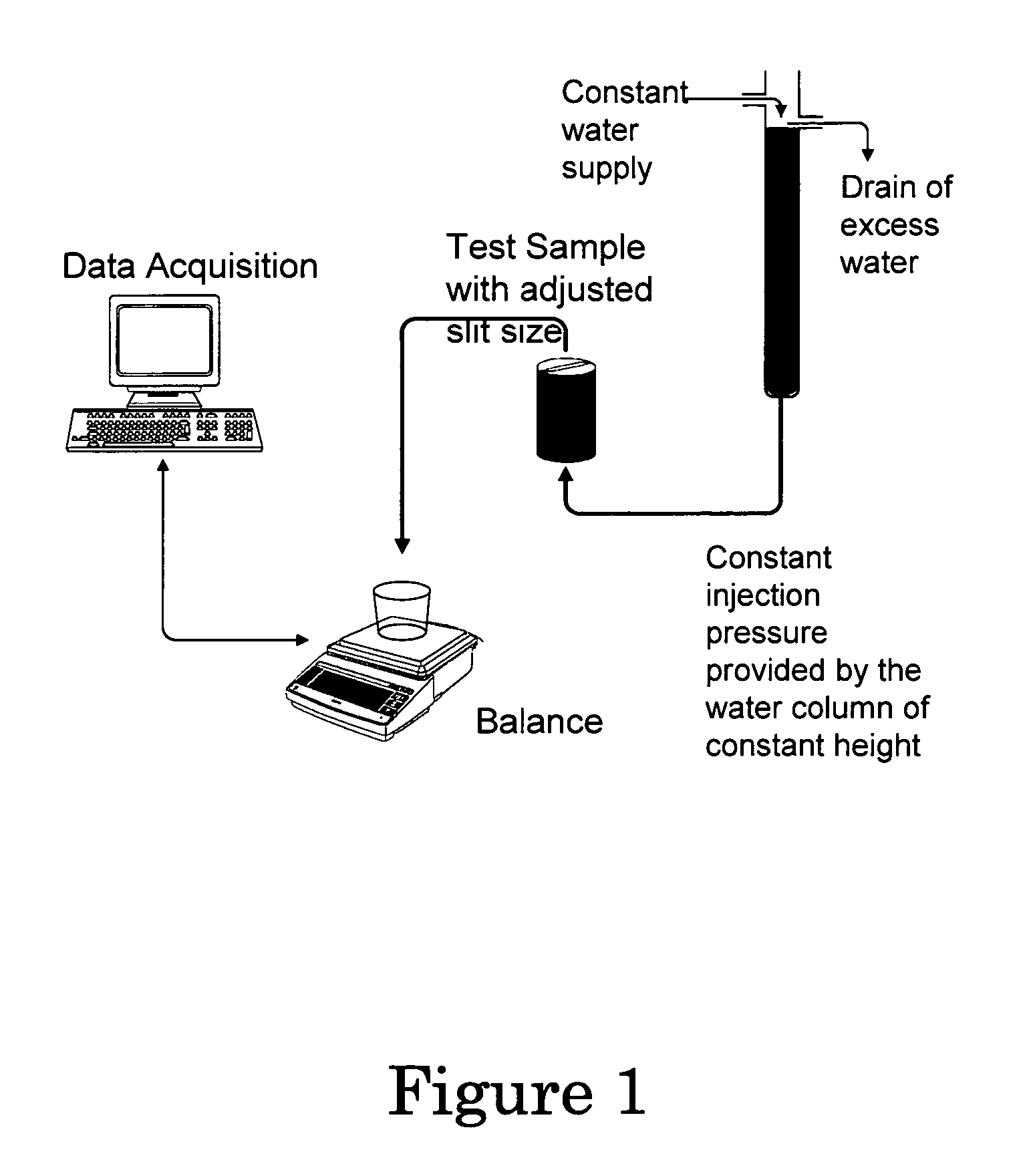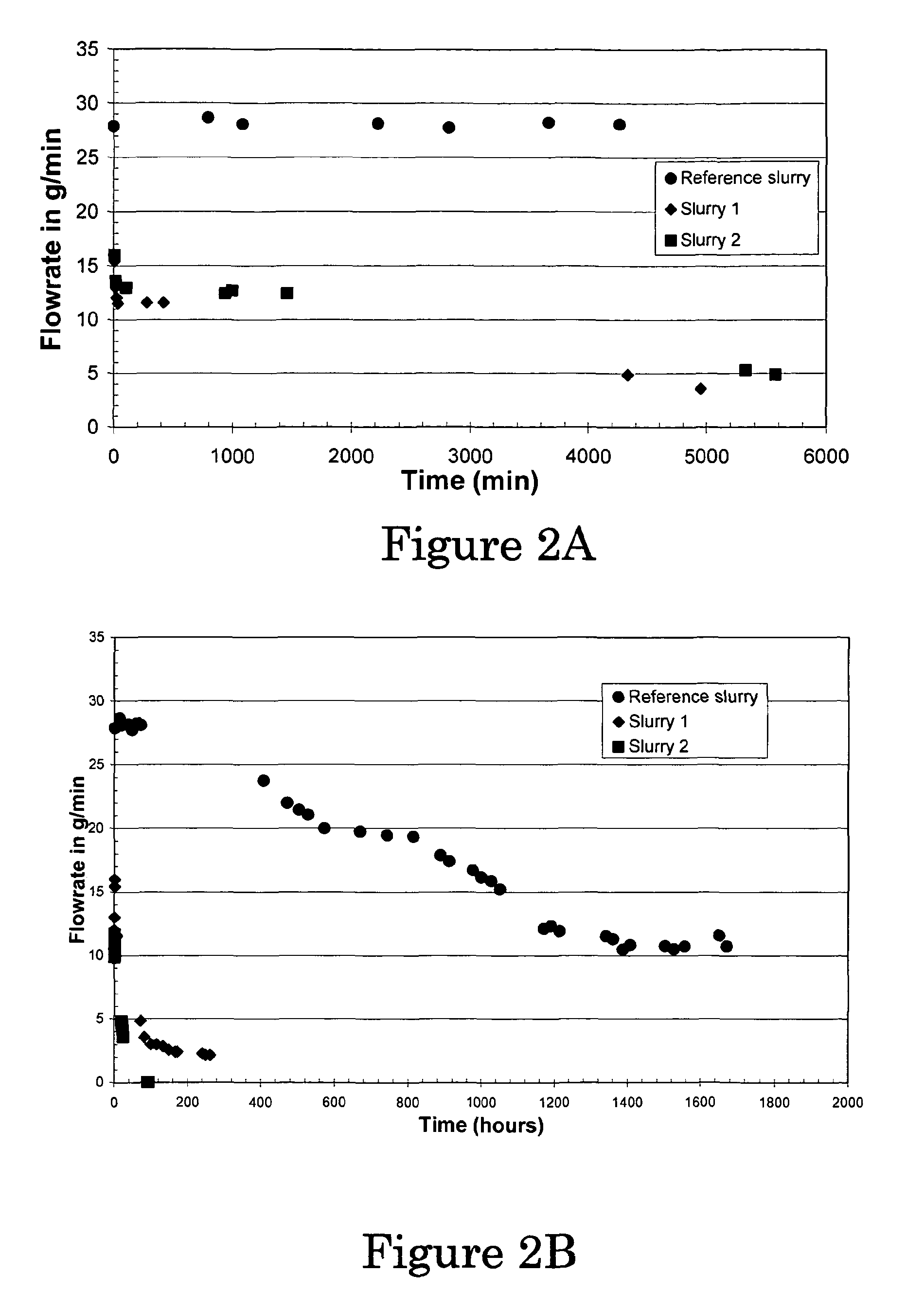Cementing composition comprising within un-reacted cement
a technology of unreacted cement and cement composition, applied in the direction of drilling composition, chemical apparatus and processes, etc., can solve the problems of cracks and/or micro-annuli, damage to the set cement, etc., to improve toughness, prevent cracks, and improve mechanical properties
- Summary
- Abstract
- Description
- Claims
- Application Information
AI Technical Summary
Benefits of technology
Problems solved by technology
Method used
Image
Examples
example 1
Slurry with Water / Oil Emulsion
[0036]Two slurries with an oil / water emulsion have been optimized. Slurry designs and properties are given in Table 1. The properties were measured according to standard API 10 (American Petroleum Institute) procedures. The cement slurries were composed of Dyckerhoff class G, black label type cement, water, oil, a dispersant agent and a surfactant. The dispersing agent was a polynaphthalene sulfonate in liquid form. The surfactant was a sulfated ethoxylated nonyl phenol. For design A the water-to-cement weight ratio is equal to 0.29 for design B the ratio decreases up to 0.37. To get a fully hydrated cement, the minimum water-to-cement weight ratio is equal to 0.38.
[0037]
TABLE 1Slurry design and properties for water / oil emulsionSlurryABW / C0.290.37Density g / cm3 (lbm / gal)1.81 (15.1)1.61 (13.4)SVF (%)38.230Cement g742.7583Water g216214Oil g116159.5Dispersant g7.42.2Surfactant g2.94.1PropertiesRheology after mixingPV in cP10758Ty in lbf / 100 sqft24.5Rheology...
example 2
Slurry with Cement Blend at Different Particle Size
[0038]Two type of blends optimized from Packing Volume Fraction (PVF) have been studied. Designs are given in Table 2. In that case the water-to-cement weight ratio is very low and equal to 0.25 or to 0.26.
[0039]The cement slurries were composed of Dyckerhoff class G, black label type cement, of microfine cement, fine cement blend amorphous silica fume, a dispersant agent, an antifoam agent and water. The dispersing agent was a polynaphthalene sulfonate.
[0040]In both cases the water-to-cement weight ratios are very low and equal to 0.25 or to 0.26. The microfine cement, the fine cement blend and the amorphous silica fume will react also with water to form cement hydrates thus participating to low water-to-cement weight ratio.
[0041]
TABLE 2Slurry design and properties for cement blendSlurrySlurry 1Slurry 2Water to Total cement ratio0.250.26Density g / cm3 (lbm / gal)2.13 (17.8)2.08 (17.36)Porosity (%)4545Water g250254Class G cement g15021...
example 3
Characterization of Self-Healing Properties with Water
[0042]An experimental set-up was developed to follow up and evaluate the self-repair capability of the tested cement. The principle is based on water permeability measurement versus the time.
[0043]The selected process to crack the cement is quite severe because it consists to cut the tested samples in two halves. Equivalent tests have been carried out on high strength concrete (Ref H. W. Reinhard, M. Jooss Cement and Concrete Research 33 (2003) 981-985). This paper establishes permeability and self-healing behavior of cracked concrete as a function of temperature and crack width. They conclude that the decrease of the flowrate depends on crack width and temperature: as expected smaller cracks do heal faster than greater ones and higher temperature favors faster self-healing process.
[0044]The set-up consists of a constant pressure system which feeds the test cell with water at 0.08 bar. The principle is shown on FIG. 1. The test c...
PUM
| Property | Measurement | Unit |
|---|---|---|
| Solid Volume Fraction | aaaaa | aaaaa |
| Solid Volume Fraction | aaaaa | aaaaa |
| weight ratio | aaaaa | aaaaa |
Abstract
Description
Claims
Application Information
 Login to View More
Login to View More - R&D
- Intellectual Property
- Life Sciences
- Materials
- Tech Scout
- Unparalleled Data Quality
- Higher Quality Content
- 60% Fewer Hallucinations
Browse by: Latest US Patents, China's latest patents, Technical Efficacy Thesaurus, Application Domain, Technology Topic, Popular Technical Reports.
© 2025 PatSnap. All rights reserved.Legal|Privacy policy|Modern Slavery Act Transparency Statement|Sitemap|About US| Contact US: help@patsnap.com



